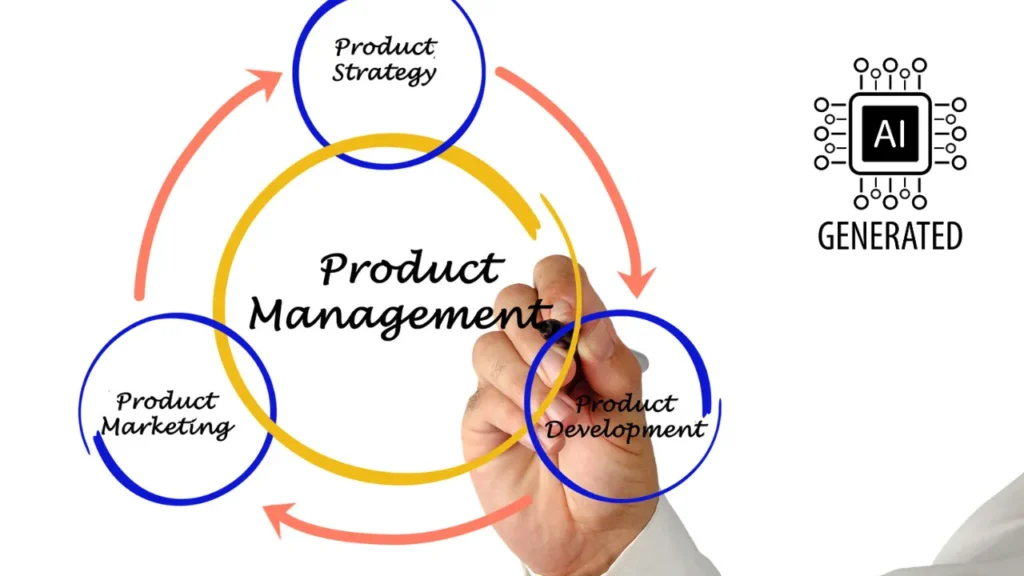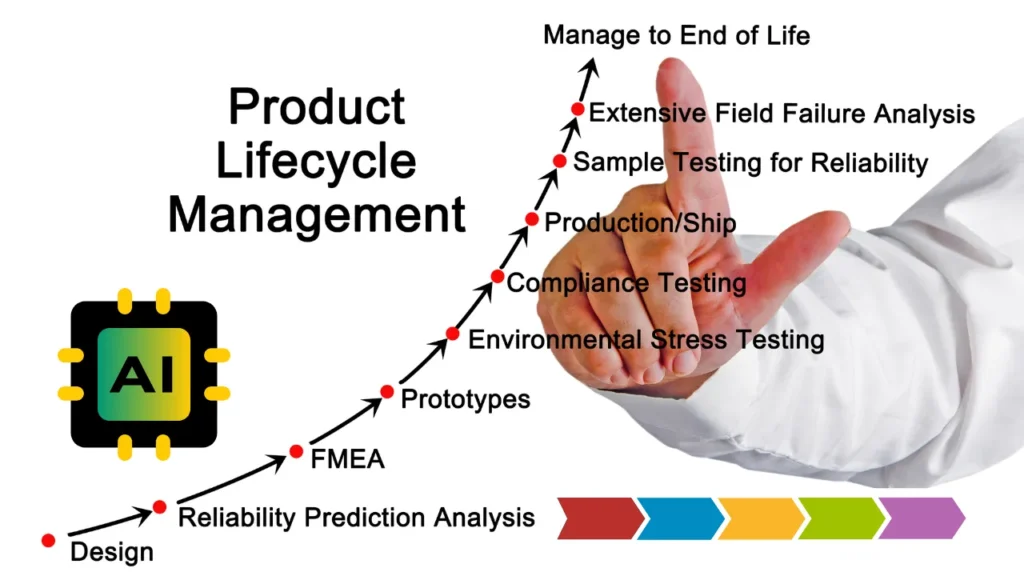Key Takeaways
Generative AI helps product managers:- Enhanced Decision-Making: Generative AI tools such as ChatGPT and Bard empower product managers to analyze data and improve decision accuracy.
- Streamlined Processes: Automates repetitive tasks and accelerates workflows, allowing managers to focus on strategic initiatives.
- Improved Customer Insights: AI-driven analysis of feedback and trends provides actionable insights to enhance user satisfaction and refine products.
- Innovative Product Development: Utilizes data-driven insights to create customer-centric and competitive AI features, ensuring market relevance.
How can product managers use state-of-the-art AI technologies to improve decisions, expedite processes, and provide outstanding customer experiences?
This question is now necessary to the future of Generative AI for product management due to the quick development of AI technology.
From automating repetitive chores to evaluating consumer information and generating creative new ideas, generative AI has revolutionary potential. Product managers’ jobs are being revolutionized in 2025 by technologies such as ChatGPT, Jasper, and Bard, which help them remain ahead of the competition.
This article explores how product managers might function efficiently, effectively, and intelligently with the help of generative AI.
To avoid AI detection, use Undetectable AI. It can do it in a single click.
Table of Contents
Generative AI for Product Management: Creating Products Driven by Gen AI

Why Develop AI Features?
Artificial intelligence (AI) technologies have enormous potential to boost sales, market share, and stickiness if implemented properly. In reality, when customers become accustomed to AI capabilities or when competitors outperform them, businesses in many industries may be pushed backward by their failure to build AI products.
However, generative driven by AI products are costly to produce, and errors can erode consumer trust. In order to acquire leadership support for AI product development, project managers should present an effective business case.
The positive aspect is that the aforementioned statistics are quite convincing! Market research and targeted use cases can serve as the foundation for an effective artificial intelligence product vision developed by PMs promoting a new AI feature or product.
Using UVPs in Generative AI Products
What your company performs effectively today can influence what AI feature your team develops tomorrow.
What is the Unique Value Proposition (UVP) that your team can capitalize on?
Furthermore, the entire company plan and the AI product strategy should coincide. Where is the company progressing?
Are you trying to determine ways to improve your current features or generate additional sources of income?
Data drives Gen AI products.
What sort of data does our company have?
This is the primary question that PMs developing Gen AI products should ask themselves.
How can I employ it responsibly?
Gen AI Product Examples that Complement Current UVPs
Industry expertise: Using Bloomberg’s private data, BloombergGPT is a finance LLM.
Data generation: Salesforce Einstein provides users access to exclusive data that can only be generated through Salesforce CRM.
Efficiency: GitHub CoPilot is a coding helper driven by AI that can both write new code and decipher existing code.
Selecting the Best Gen AI Engine with LLMs in Product Management

AI products are driven by large language models, or LLMs. To comprehend, produce, and modify human language for a variety of uses, these sophisticated artificial intelligence systems are trained on enormous volumes of textual data. To operate their Gen AI products, product teams frequently rely on pre-existing LLMs.
Read Also >>> AI Twitch Clip Generator
Unconventional similar to cookbooks, LLMs offer a vast array of recipes, but a chef should hone and experiment with them to produce a signature dish. In a similar vein, these models need additional training to become proficient at particular activities and provide remarkable outcomes.
Prompt Engineering
The positive aspect is that LLMs can communicate with people using prompts due to their broad knowledge, a technique termed prompt engineering. System prompts are prompts that are used to train LLMs. In certain situations, prompting could be sufficient to offer the LLM instructions on how to perform a task.
Others require optimization or training. In this context, retrieval-augmented generation (RAG) and fine-tuning are the two primary techniques.
Fine-Tuning
In addition to using prompts to teach a pre-trained model (such as GPT 4) on task-specific custom data sets, the learning rate can be changed in the hyperparameters (the LLM’s higher-order settings) to have precise and minor modifications without affecting the initial training.
Retrieval Augmented Generation
RAGs integrate two distinct model types: generative and retrieval. Similar to search engines, retrieval models provide targeted information in answer to requests. Together with LLMs, they provide a RAG that can deliver highly contextual information about a particular use case in natural language.
RAGs are enriched with specialized information that is not just a Google search away, in contrast to an app such as ChatGPT that uses publicly available data as its knowledge base.
Examples of Generative AI Products Driven by LLMs
Today, there are hundreds of LLMs, and the number is still rising. Selecting the LLM that best meets the objectives they have is the initial step for many product teams faced with creating a driven by AI service.
GPT: The LLM that drives ChatGPT, the app that popularized generative AI, was created by OpenAI and is designated as GPT. The recent version, GPT-4 Omni (GPT-4o), accepts text, images, and audio as inputs.
Claude: Anthropic created it with integrity, harm reduction, and enterprise customers’ data security in consideration. Claude is a partner of Zoom, Notion, and Slack.
Mistral: Mistral is another name for the business that created this model. Despite having fewer parameters, it outperforms other models using sub-system technology, which enables it to operate quickly on less potent hardware.
Gemini: Google created the Gemini (previously Bard) models, which are connected with Google search engine and have native support for text, code, graphics, and video.
Key Factors to Consider Before Selecting an LLM
Cost effectiveness: Higher usage fees may also apply to larger and potent models, particularly if they be accessed through an API (such as OpenAI’s GPT API). If you’re using an API to access the LLM, consider the pricing structure, which frequently includes fees per request, compute time, or token (about four characters in English).
Fine-Tuning: To better match the model’s performance with the specifications of your product, see whether it can be adjusted for your particular dataset.
Data Security: Assess any biases or privacy issues by understanding the type of data the LLM was trained on, in particular when the model was pre-trained on publicly accessible data.
If your product handles sensitive or private data, verify that the LLM’s operating procedures and instructions comply with relevant data protection legislation, such the GDPR.
Use Case: Product Managers’ Utilization of Gen AI to Gain Customer Understanding

For many businesses, the lucrative use of generative artificial intelligence (AI) applications is to enhance the customer experience. Businesses may use generative AI to enhance customer experiences and boost productivity by 30 to 45 percent, according to McKinsey’s Economic Potential of Generative AI report.
Here, our focus is at how project managers may address the deluge of customer support data and user input to enhance and create customer-focused products.
Using Generative AI for Customer Feedback Analysis
With the use of machine learning and large language models, generative AI models provide previously unheard-of real-time comprehension and processing capabilities for enormous volumes of client data.
Product teams are now better equipped than ever to recognize market trends, comprehend client pain areas, and improve user experiences due to technological advancements. In order to improve user satisfaction and refine products, it is necessary to comprehend client feedback.
Generative AI is a potent tool for deriving insightful information from a variety of consumer feedback sources, in particular when paired with Natural Language Processing (NLP) techniques. Here is a detailed tutorial on using AI to analyze customer feedback:
Combining Client Input
Start by collecting input from every pertinent source. This includes support tickets, product evaluations, consumer surveys, social media comments, and forum conversations. The objective is to have an extensive dataset that reflects the opinions of your clientele.
- Support Tickets: Collect tickets from your platform for customer service.
- Product Reviews: Compile reviews from the app stores, your website, and any other websites that list your product.
- Surveys: Compile the findings of recent questionnaires asking about product or customer satisfaction.
- Social Media & Forums: Compile feedback and conversations regarding your product from pertinent forums and social media sites.
Preparing the Data
Combine the input that has been collected into an organized format that can be used for analysis. This could entail standardizing formats for consistency between sources, fixing errors, and cleaning the data to eliminate unnecessary information.
Applying NLP to Preliminary Analysis
Process the text data using NLP algorithms. This includes:
- Sentiment Analysis: To assess customer satisfaction, determine the general sentiment (positive, negative, or neutral) of each item of feedback.
- Keyword Extraction: To draw attention to recurring themes, identify key terms and phrases that are used often in the comments.
- Entity Recognition: Identify and classify significant entities, such as features of a product, problems, or particular services that clients have highlighted.
Using Generative AI to Summarize
Use a generative AI model to input the processed data in order to identify and summarize key issues. One way for programming the model is to:
- Summarize Individual Threads: Highlight the key ideas and issues raised in lengthy customer emails or support ticket threads in succinct summaries.
- Combined Insights: Using categories such as product features, usability, customer service quality, etcetera., create a report that summarizes the common themes and feelings found in every piece of the feedback that was gathered.
Identifying the Primary Problems and Possibilities
Analyze the summaries produced by AI to determine the commonly reported issues and potential areas for development. Search for trends that point to systemic problems or chances for major improvements.
Example: Analyzing Emails from Customer Support
Consider that you want to search for recurring problems and themes in a month’s worth of customer support emails. Here’s one way to use generative AI to approach it:
Data Preparation: Create a single dataset by compiling each of the customer emails you have received in the past month. Verify that the data is consistent in format and clean.
NLP Processing: Utilize natural language processing (NLP) to examine every email, extracting key phrases and sentiment, and classifying the issues that are discussed (such as technical issues, billing questions, and usability feedback).
AI Summarization: Create summaries for every email conversation by feeding the NLP-processed data into a generative AI model. Configure up the AI to concentrate on capturing the primary points of the client’s issue or criticism.
Aggregate Analysis: Based on the complete dataset, have the AI model produce a broad synopsis that identifies the prevalent issues, encouraging comments, and areas for development.
Review and Action: Determine the significant areas for action by heading over the summaries and general evaluations produced by AI. This can entail resolving frequent bugs, addressing typical usability difficulties, or improving customer service for particular problems.
Product teams can use these techniques to turn unfiltered client feedback into useful insights that can be used to inform data-driven decisions that improve customer experience and product development.
This systematic strategy promises that each and every piece of input is respected and considered for the product’s ongoing improvement.
Generative AI for Product Management: Boost Efficiency and Improve Workflow

Gen AI can help PMs become productive on a variety of job responsibilities. Chatbots and other AI tools can increase product managers’ productivity in the following ways:
- Developing fresh concepts
- Considering the benefits and drawbacks
- Setting everyday activities as a priority
- Simplifying procedures
Generative AI Products for Product Managers
In addition to general-purpose Gen AI tools such as ChatGPT, PMs can choose from product-specific options. Product Teams were considered in the design of these technologies:
- Use LogRocket Galileo AI to transform session replays into insights.
- Use Productboard AI to base your product backlog on user feedback.
- Use Chameleon’s Helpbar to turn your resources section into a chatbot.
- Use Mixpanel to extract key insights from large data sets.
- Use Sprig to create better PRDs, surveys, etcetera.
Conclusion: Using Generative AI for Product Management
By 2025, product managers might employ generative AI as a co-pilot rather than just a technology. Product managers have to rely on AI as it develops for creativity, effectiveness, and customer-focused decisions. Adopting these technologies is necessary to be competitive in the current product market; it is not merely a choice.
Product management is changing due to generative AI, becoming inventive, quicker, and smarter. Product managers in 2025 can remain ahead of the curve and guide their teams to develop significant, user-focused products by using its potential.
FAQs: Using Generative AI for Product Management
What is Generative AI and how does it relate to product management?
Generative AI refers to a category of artificial intelligence that can create new content, such as text, images, and even music, by learning from existing data. In the context of product management, generative ai can assist product managers in various ways, including ideation, user feedback analysis, and market trend predictions.
By leveraging AI for product development, product teams can enhance their product strategy and streamline the product lifecycle.
How can Generative AI for product managers enhance product innovation?
Generative AI for product managers can significantly enhance product innovation by providing insights derived from AI models and large language models (LLMs). For instance, product managers can use Gen AI tools to analyze customer feedback and generate new features or improvements based on user needs.
In addition, the power of generative AI lies in its ability to simulate various market scenarios, enabling product leaders to make informed decisions about product direction.
What are some real-world use cases of Generative AI in product management?
Real-world use cases of generative AI in product management include automated report generation, where AI-powered products compile data and generate insights for product teams. Another example is personalized user experience, where generative AI analyzes user behavior to tailor recommendations.
In addition, AI in product management can assist in market research by generating surveys and analyzing responses to identify trends.
What are the key benefits of using AI for product managers?
The key benefits of using AI for product managers include increased efficiency, improved decisions, and enhanced customer insights. By utilizing generative AI models, product managers can quickly analyze large datasets, reducing the time spent on manual analysis.
Furthermore, AI technologies can offer predictive analytics, helping product teams foresee potential challenges and opportunities in the market.


